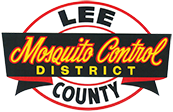Have you noticed that the exterior walls of your home have taken on a coating of mosquito-like insects? Perhaps you have returned to your winter home and found staining on the walls, boat, sidewalks and wondered what happened to your property in your absence or based on the odors drifting by suspected your neighbor of running a fish processing operation? If you answered yes, you probably live near a lake, pond, canal, or water body, which is producing massive amounts of aquatic midges often called blind mosquitoes. Blind mosquitoes are mosquito-like insects belonging to the family Chironomidae. They look like mosquitoes but do not bite, suck blood, or carry disease like mosquitoes.
Midges lay their eggs on surface of water bodies that range from 3-12 feet deep. The eggs sink to the bottom where they will hatch in 2 to 7 days. Larvae, that hatch from the eggs, burrow into the organic matter or mud forming small tubes and tunnels. The larvae look like thin worms and are often referred to as bloodworms because they often have red coloration. Over the next 2 to 7 weeks, the larvae continue through their development to pupae and hatch into winged adults. Unlike mosquitoes, midges do not feed. The adults only live 3 to 5 days. Keep that in mind when suffering through a massive hatch; it will get better soon.
Midges usually hatch between April and November with two peak hatches. They are attracted to the lights around houses. If they cling to the walls or die in spider webs, they will stain stucco, paint, or other finishes. They will stain just about any surface they die on inside your home too. Midges smell like rotting fish as they decay and will leave behind an odor that lasts long after you have washed away the dead insects.
Control treatments are very expensive, add more pesticides to our environment, and only provide short-term relief. For the individual homeowner, it is best to daily wash down midges that cling to surfaces, avoid exterior lighting during outbreaks, and be cautious with the use of fertilizers. Neighborhoods may wish to switch to use of high-pressure sodium lights, which are less attractive to midges.
Aquatic midges are often an indicator of poor water quality. The insects prefer bodies of water subjected to heavy effluents from septic tanks, sewage treatment plants, and leaching of fertilizers from homeowners, golf courses and agricultural applications. As pollution increases, the food for midge larvae increases and populations explode. If you are concerned or have questions about the water quality of your neighborhood retention pond or lake, please visit the Lee County Hyacinth Control District’s website where you can learn about the citizen-driven Pond Watch program: https://lchcd.org/pond-watch-program/.
